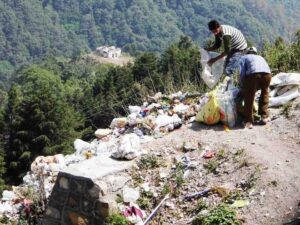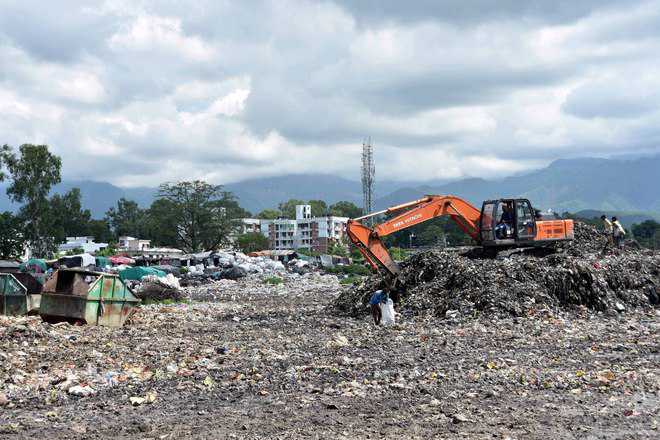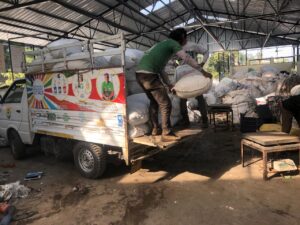Dehradun is drowning in its own waste
Moreover, over 50 tonnes of waste remains uncollected every day and keeps on piling up on the streets and open lands across the entire district. Years of this neglect has led to a situation where it is apparent that the entire Doon valley is crumbling under the pressure of an increasing urban population with vast swathes of waste spanning its land and water bodies. Rising living standards and increase in consumption levels are as much responsible as poor waste segregation methods and poor awareness.
According to the government, India generated about 62 million tonnes of waste in the year 2016. Another report, from 2018, ranked Uttarakhand, which processed nearly zero pc of the total waste produced in the state, at the bottom of the pile in terms of waste management. This, despite the fact that tourism is perhaps the leading sector of Uttarakhand’s economy and untreated waste lying all around hardly makes for a touristic experience. However, tourists also contribute to the waste production and its bad disposal.
Uttarakhand Environment Protection and Pollution Control Board estimated the state’s solid waste generation at 900-1500 metric tonnes per day. As the environmental laws prohibited setting up of any recycling plant within the Doon valley to curb pollution, Uttarakhand does not have any processing plants or landfills, although the government has announced six locations to set up plants in the state. Presently, the segregated waste is sent to other cities like Delhi (Tikri), Meerut, etc.
Despite Dehradun being named as one of 100 smart cities in the country way back in 2014, only 25 pc of the city is serviced by a sewage system. Similar to the ever-higher Ghazipur landfill in Delhi, which has been overflowing since 2002, landfills in Dehradun also have exceeded their capacity. As a result of heaps of untreated waste lying for years, air and water contamination have become major problems for people living in the vicinity of these sites, notably near Doon University, Kargi Chowk and Sahastradhara.
Under the Jawaharlal Nehru National Urban Renewal Mission 2005, Dehradun was selected for urban infrastructure and services development in terms of housing, water supply and sanitation. However, the valley echoes a different waste management story.
Sahastradhara and Sheesambada
Over the years, Sahastradhara, a large locality that is also home to dozens of waterfalls, has become a dumping zone. In the absence of any government intervention and door-to-door waste collection, the landfill has turned into a major predicament for the locals, even though the site was shut by the government that directed all the waste produced in the capital and moved to the centralised solid waste processing plant in Sheesambada.
However, this led the residents of Sheesambada to rise in protest against the plant since its inception in 2015. In addition to noise pollution and foul smell from the rotting garbage, the plant has contaminated air and surrounding water bodies, they say. News reports also pointed to a rise in respiratory infections and waterborne diseases and the residents allege that many people in the area have died due to cancer in recent years.
Poor management at Sheesambada
Waste management experts say that Sheesambada plant does not administer proper composting procedure. “Before proceeding with door-to-door collection of waste, awareness should be generated among the residents following the IEC method (Information, Education and Communication), which was not carried out,” says a member of Waste Warriors, a Dehradun-based NGO specialising in waste management.
The daily waste capacity of the plant is around 250 tonnes. “A landfill was assigned next to the composting unit where they were supposed to dump non-recyclable waste. However, composting of wet waste is done by Windrow method in which only biodegradable or organic waste is hauled in long rows. Moreover, the landfill looks similar to the Ghazipur landfill in Delhi,” he mentions.
Contaminated rivers
Kargi Chowk houses a waste transfer station in the city, along with Sahastradhara and Indiranagar. Being the primary transfer station in the city, it has a capacity of 150 tonnes per day. Despite the enormous containment capacity, the area faces a problem of open dumping. The Bindal river flows alongside and is fed by the springs from Mussoorie and piles of waste pose a hazardous risk to the river.
Both the Bindal and Rispana river form a major portion of the urban drainage network in Dehradun. The rivers later confluence at Suswa. Major industrial effluents from distillery and sugar mills pollute the rivers, especially Suswa and Song. Due to untreated waste from industry being dumped in them, these rivers now have very high levels of toxic elements like chromium, zinc, iron, lead and oil which are harmful for humans, marine life and the soil as well. It has a direct and very negative effect on agriculture.
Under the Namami Gange programme, the Central Pollution Control Board (CPCB) identified a stretch of the river Suswa as polluted. The Suswa river marks the northern boundary of the Rajaji National Park. The wildlife of the Park feeds on its water. The Uttarakhand Human Rights Commission had summoned the Director of the Tiger Reserve over the high quantity of life-threatening toxins in the river. The aftermath of these actions was inconsequential as Namami Gange has so far proven to be totally ineffective.
Nagar nigams and the continued efforts
Waste collectors make a living out of collecting waste that lies uncollected and unsegregated. However, they are not trained waste pickers or qualified waste management professionals. “We collaborated with UNDP and Dehradun municipal corporation to enroll the waste-pickers, a majority of whom are from Central India. They were registered as formal workers and have been provided with suitable protective gears like gloves for waste collection,” says the member of Waste Warriors.
He goes on to say that even though the municipal authorities in many Tier 2 and Tier 3 cities suffer severe fund crunch, the Dehradun municipal officials help these NGOs in land and legal affairs. Garbage trucks for door-to-door collection are also provided for the workers, which have segregated slots for different types of waste like recyclable waste, non-recyclable waste, wet waste, etc.
The Indian waste industry is projected to be worth USD 14 billion by 2025. However, the industry is largely unregulated, with millions of informal workers. Collaborated efforts of the NGOs with the municipal authorities have been marginally successful in raising awareness among the locals about waste segregation and disposal. Time and again, the Nagar Nigam has tried to convince the hotels and restaurants in the city to segregate their waste. However, it is a costly and time-consuming exercise for the owners.
Despite much greater awareness about the importance of cleanliness and the increasing urgency of ensuring proper treatment and recycling of industrial and domestic waste, the heaps of garbage continue to rise in the Doon valley and rest of the Himalayan state that often likes to compare itself to Switzerland. Minus the garbage, of course.













